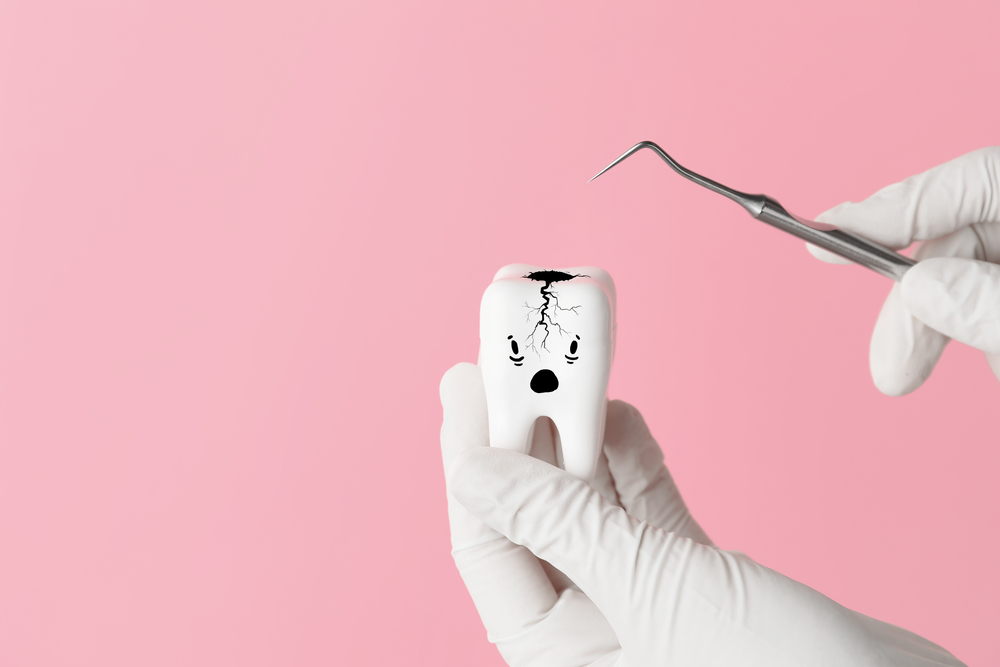Cracked teeth can be a painful and frustrating experience, and it’s essential to understand what causes them and how they can be treated. In this post, we will take you through the different types of cracked teeth, their symptoms, and the primary causes behind them. We will also explore professional diagnosis techniques, including modern diagnostic tools used to identify your condition’s severity. Finally, we will delve into available treatment options for cracked teeth, including preventative measures to help you avoid future dental issues. So, whether you’re experiencing tooth pain or simply want to learn more about dental health, keep reading to learn everything there is about cracked teeth and how they can be treated.
Craze Lines
Craze lines, which are superficial cracks affecting the enamel, are usually harmless but can worsen with severe tooth decay. Treatment may involve dental bonding or porcelain veneers, addressing the excessive force on the tooth causing craze lines. Incorporating NLP terms such as “surface of the tooth” and “dental practice,” the American Association of Endodontics recommends seeking an endodontist’s expertise for much pain associated with craze lines. Though often harmless, these lines can lead to significant discomfort, warranting swift action.
Fractured Cusp
Fractured cusp cracks occur when a piece of the tooth’s chewing surface breaks off, often caused by chewing complex objects or foods. Treatment for fractured cusp cracks may involve a dental crown or filling and can be diagnosed through dental X-rays and examinations. These cracks can lead to much pain if left untreated, emphasizing the importance of visiting a dental practice for prompt care. The American Association of Endodontics (AAE) recommends seeking the expertise of an endodontist for such conditions.
Split Tooth
Split teeth result from incomplete fractures in the tooth, often caused by severe decay. Treatment may include root canal therapy or extraction, depending on the severity. The American Association of Endodontics recommends seeking professional help if experiencing much pain or other symptoms. It’s essential to address split teeth promptly to prevent further damage to the natural tooth. An endodontist specializing in dental practice can provide the best treatment plan based on the specific condition of the split tooth.
Vertical Root Fracture
Vertical root fractures originate at the tooth’s root and progress upwards. Warm water rinses can help ease discomfort from these fractures, while severe cases may require tooth extraction. Complications, such as gum swelling, can arise from vertical root fractures. Incorporating NLP terms like “surface of the tooth,” “root canal treatment,” and “endodontist” can enhance the content. The American Association of Endodontists (AAE) recommends seeking dental practice advice for much pain linked to vertical root fractures.
Physical Trauma
Physical trauma to the teeth can result from accidents, falls, or sports injuries. Immediate dental care is often necessary for cracked teeth caused by such trauma. Depending on the severity, the dentist may recommend a root canal or extraction for a broken tooth. A damaged tooth due to physical trauma can sometimes be treated with a plastic resin filling, providing relief and restoring the natural tooth surface.
Wear and Tear
Normal chewing can lead to cracks in teeth while aging naturally wears down the enamel. The regular clenching or grinding of teeth can also cause these cracks due to excessive force. Additionally, chewing complex objects can result in tooth fractures. The tooth’s surface may undergo significant wear and tear over time, leading to potential dental issues requiring intervention from a dental practice.
Temperature Extremes
When exposed to temperature extremes, teeth can develop cracks due to the expansion and contraction of the tooth’s surface. Sudden changes in temperature, especially when consuming hot and cold foods, may lead to cracked teeth. Over time, extreme temperature variations can weaken the tooth enamel, making it more susceptible to cracks. If left untreated, these cracks can cause much pain and may require root canal treatment or even extraction.
Dental Examination Techniques
Practitioners utilize various techniques during dental examinations to identify and diagnose cracked tooth syndrome. Visual inspections play a vital role in detecting any abnormalities on the tooth’s surface, while dental explorers are used to detect cracks and irregularities. Additionally, X-rays are indispensable for identifying hidden splits or fractures within the teeth that are not visible to the naked eye. Dental magnification is also employed to detect hairline fractures, and examination of damaged teeth involves meticulously checking the gum line and enamel for any signs of damage.
Modern Diagnostic Tools
Modern diagnostic tools in dental practice have revolutionized the identification of various tooth issues. Digital radiography ensures accurate detection of tooth fractures, while intraoral cameras aid in visualizing cracked teeth. Transillumination effectively identifies craze lines, and spectracaries detection helps detect severe tooth decay. Additionally, laser fluorescence facilitates the early detection of cracked teeth, allowing for prompt intervention, treatment, and prevention of further complications. These modern tools enhance the surface of the tooth diagnosis, ensuring effective and efficient dental care.
Treatment Options for Cracked Teeth
A root canal treatment may be necessary when a cracked tooth reaches the root. Dental crowns are commonly used to restore the tooth’s surface after cracks. For front adult teeth cracks, porcelain veneers offer a natural-looking solution. Extraction might be the only option in extreme cases, especially with wisdom teeth. The severity of the crack, whether it’s a split tooth or a fractured cusp, determines the best course of action.
Conclusion
In conclusion, cracked teeth can be a painful and concerning dental issue that should not be ignored. Understanding the different types of cracks and their causes is essential in determining the appropriate treatment. If you suspect you have a cracked tooth, seeking professional diagnosis through dental examination techniques and modern diagnostic tools is essential. Treatment options may vary depending on the severity of the crack, ranging from bonding and crowns to root canal therapy or extraction. Prevention is key, so practice good oral hygiene, avoid biting complex objects, and wear a mouthguard during physical activities. Caring for your teeth is crucial for maintaining a healthy and beautiful smile.

 Dr. Paul King
Dr. Paul King Dr. Chris King
Dr. Chris King


